Obd2 Teklink Software


Screenshot by Antuan Goodwin/CNET Your car's dashboard is probably home to a speedometer, a tachometer, a fuel gauge, and -- if you're lucky -- a coolant temperature gauge. However, your car's electronic brain (ECU) is actively monitoring dozens of parameters behind the scenes that you, the driver, could find useful. This is where diagnostics hardware and apps like Torque Pro and Lite for Android step in, putting all of that data at your fingertips. Torque doesn't require anything more than the hardware already present on your Android phone to function.
Without any external hardware, Torque can still pull sensor data from your phone's GPS antenna, internal compass, barometer, and accelerometer. That data alone gives Torque Pro enough infomation to calculate 0-60 and quarter-mile times and to record and export historical position logs to Google Earth. We used the PLX Kiwi Bluetooth to supply OBD-II data to the Torque Pro app. Antuan Goodwin/CNET. However, it's not possible to take full advantage of the app's full functionality -- to really dive deeply into the inner workings of your car's electronic brain -- without a connection to your car's OBD-II port. For my testing, I made use of the, which plugs into the vehicle's diagnostics port (OBD-II) and paired with my Android phone wirelessly, to transmit the full spectrum of available vehicle data to the app. Silverchair - Live At Melbourne Park 1999 on this page. Real-time information Firing up Torque Pro brings the user to a home screen where the app's five main functions (Realtime Information, Check Fault Codes, View Map, Test Results, and Graphing) can be selected and accessed.